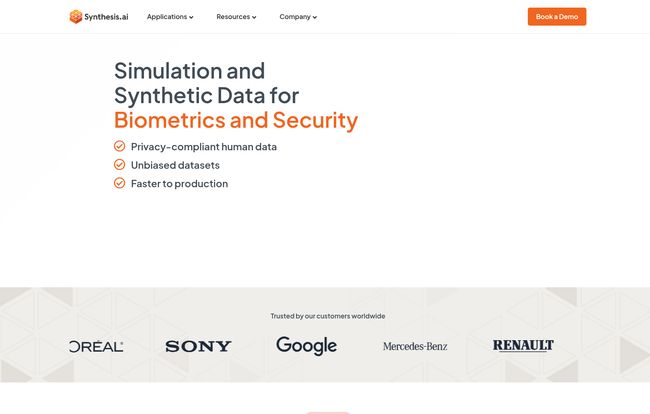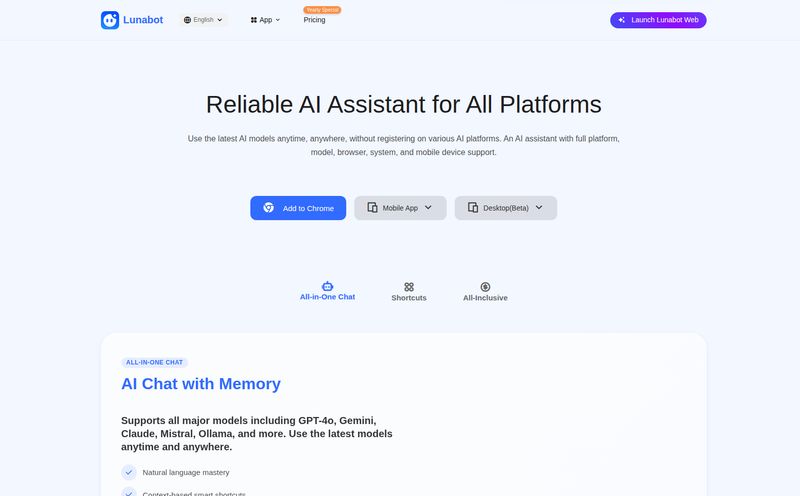If you’ve been in the AI or machine learning space for more than a minute, you know the industry has a dirty little secret. It’s not the algorithms, it’s not the hardware... it’s the data. We’re obsessed with it. We hoard it, we scrape it, we buy it. We're told that Big Data is the answer to everything. But I've been in this game long enough to know that more data isn’t always better data. Sometimes, it’s just more problems.
We’re talking about data that’s riddled with biases, data that comes with a whole suitcase of privacy nightmares (hello, GDPR), and data that just… doesn’t exist. How do you train a self-driving car to react to a moose jumping onto the highway at dusk in the rain? You can't exactly park a camera crew on the side of a Canadian highway and wait. It’s this exact headache that has companies scrambling for a better way. And that’s where things get interesting, and platforms like Synthesis AI start looking less like science fiction and more like a dead-sensible solution.
I first saw their name pop up when I noticed they were trusted by giants like Google, Mercedes-Benz, and Sony. You don't get that kind of client list by selling snake oil. So, what are they selling? In a nutshell: perfect, custom-built, simulated data. Think of it as a Hollywood VFX studio for your AI models.
So, What Exactly is Synthesis AI?
Imagine you need to train an AI to recognize people for an ID verification system. The old way? You’d need to collect millions of photos of real people. This means getting consent, storing the data securely, and praying you’ve captured enough diversity in ethnicity, age, lighting conditions, and whatnot to avoid creating a biased system. It’s an expensive, slow, and risky process.
Synthesis AI flips that script. Instead of finding real data, it generates it. It creates photorealistic, 3D synthetic humans and places them in any scenario you can dream of. Need a million unique faces for ID verification? Done. Need to test how your in-car monitoring system detects a sleepy driver at night? They can simulate that. It's like having a flight simulator for your perception AI, letting it crash and learn in a virtual world before you let it loose in the real one.

Visit Synthesis AI
Why We’re Drowning in Data, But Starving for Quality
The core value here isn't just about making more data. It's about making the right data. Synthesis AI is tackling some of the gnarliest problems in computer vision today.
The Privacy Problem Is a Ticking Time Bomb
I can't stress this enough. Using real peoples faces and data is becoming a legal and ethical minefield. One wrong move, one data breach, and you're not just facing a massive fine; you're facing a total loss of customer trust. Synthetic data elegantly sidesteps this entire mess. The 'people' in Synthesis AI's datasets don't exist. They have no identity, no privacy to violate. They are, for all intents and purposes, digital stunt doubles. This isn't just a nice-to-have feature; in a post-GDPR world, its a fundamental requirement for responsible AI development.
Tackling the Unseen Bias in Our Algorithms
AI bias is a huge, documented problem. If your training data predominantly features one demographic, your AI will be great at recognizing that demographic... and terrible with everyone else. This has led to some pretty awful and well-publicized failures in commercial products. With synthetic data, you are the master of your own universe. You can dictate the exact demographic mix, ensuring your dataset is perfectly balanced. You can generate images across a spectrum of skin tones, ages, and facial features, something that is practically impossible to achieve with real-world collection. This isn’t just about fairness; it's about building a product that actually works for everyone.
Chasing Unicorns and Dangerous Edge Cases
This is the part that really gets my inner geek excited. What about the rare stuff? The long-tail events? A pedestrian stepping out from behind a bus on a foggy night. A user trying to operate your AR headset in a weirdly lit room. These are the edge cases that can make or break a product, or in the case of autonomous vehicles, be the difference between life and death.
Synthesis AI allows developers to simulate these high-stakes, low-frequency events over and over again until the AI knows exactly how to handle them. You can't do that in the real world. This accelerates the development cycle immensely because you're no longer waiting for the world to give you the data you need. You're creating it on demand.
Putting Synthesis AI Under the Microscope
Okay, so the theory is solid. But where is the rubber meeting the road? The applications are already widespread and pretty impressive.
Real-World Applications That Are Already Here
You can see the direct lines between their offerings and their client list. For brands like L'Oréal, the ability to generate synthetic data for virtual try-on applications is a game-changer. For automotive giants like Mercedes and Renault, it's all about robust driver monitoring and pedestrian detection. For security applications, it’s creating foolproof ID verification systems. They're also deep in the AR/VR/XR space, helping build the next generation of consumer devices that need to understand human movement and activity.
The Understated Power of Pixel-Perfect Labels
Anyone who has ever managed a data labeling project knows the pain. It's tedious, mind-numbingly slow, and incredibly expensive. You pay teams of people to draw boxes around objects in images, and the results are often inconsistent. A huge advantage of synthetic data is that it comes perfectly labeled from the get-go. Since the entire scene is a 3D model, the system knows precisely where every single pixel of a 'person' or 'car' is. It knows the depth, the contour, the segmentation. This isn't just a minor improvement; it's a quantum leap in data quality that saves countless hours and dollars.
But Is It a Perfect Solution?
Now, I’ve been around long enough to be skeptical of anything positioned as a silver bullet. And while I'm genuinely impressed with Synthesis AI, it's important to keep our feet on the ground. There are some considerations.
The 'Garbage In, Garbage Out' Principle Still Applies
The quality of your synthetic data is only as good as the simulation engine that creates it. If the models for lighting, texture, or physics are slightly off, that 'sim-to-real' gap can trip up your AI. Synthetic data might not perfectly replicate every single bizarre, chaotic nuance of the real world. So, it's often used to augment real-world data, not replace it entirely. It fills the gaps, not the whole bucket.
A Word on Complexity
This isn't a plug-and-play tool for your weekend project. Creating effective, high-fidelity simulations that accurately reflect the scenarios you need to test requires expertise. A team needs to understand the problem domain deeply to configure the simulations correctly. It’s a professional-grade tool for a professional-grade problem, and that's reflected in their enterprise-focused approach.
What About the Cost? The Pricing Question
If you're looking for a pricing page with neat little tiers, you wont find one. Like many high-value, enterprise B2B platforms, Synthesis AI operates on a "Book a Demo" model. This makes sense. The needs of a company building an automotive safety system are vastly different from one building a virtual makeup app. Pricing is almost certainly customized based on the scale of data generation, the complexity of the simulations, and the level of support required. So, you'll need to have a conversation with them to understand the investment.
...our field must tap into rich sources of synthetic and real data. Sergey's book provides a comprehensive and compelling overview of the topic. I consider it required reading for any researcher using deep learning based methods.
My Final Take: Is Synthetic Data the New Gold?
So, back to my original question. Is this stuff the new oil, the new gold? I think it’s something more practical. It's the new assembly line. It’s the infrastructure that's going to allow us to build better, safer, and more equitable AI, faster than ever before. It takes the most unpredictable, messy part of AI development—data collection—and turns it into a predictable, scalable manufacturing process.
Platforms like Synthesis AI aren't just a trend. They represent a fundamental shift in how we approach machine learning. They're a powerful answer to the data bottleneck, the privacy crisis, and the bias problem that have been holding the industry back. It’s not magic, but it's damn close.
Frequently Asked Questions about Synthesis AI
- 1. What is synthetic data?
- Synthetic data is artificially generated information rather than being collected from real-world events. In the context of Synthesis AI, it's photorealistic, computer-generated images and data used to train computer vision models.
- 2. Is synthetic data better than real data?
- It's different. It's not always a replacement, but an augmentation. It's better for ensuring privacy, eliminating bias, and creating rare edge cases. Real data can still be valuable for capturing the unpredictable chaos of the real world. Most powerful models use a mix of both.
- 3. Who uses Synthesis AI?
- Their client list includes major global brands across different sectors. This includes tech companies like Google, automotive leaders like Mercedes-Benz and Renault, consumer electronics giants like Sony, and even beauty brands like L'Oréal.
- 4. How does Synthesis AI handle data privacy?
- This is one of its main strengths. Since all the data, including the human figures, is computer-generated, there are no real people involved. This completely eliminates the risks associated with personal data, making it compliant with regulations like GDPR and CCPA by design.
- 5. Can I use Synthesis AI for a small project?
- Given their enterprise focus and "Book a Demo" model, the platform is primarily geared towards large-scale commercial and research projects. It's not typically a tool for individual hobbyists or very small teams.
- 6. Is it hard to create data with Synthesis AI?
- While the platform is powerful, getting the most out of it requires some expertise. Defining and configuring the right simulations to generate useful data requires a good understanding of your AI's goals and the environment it will operate in. It's a tool for specialists.
Conclusion
The conversation around AI is shifting. We've moved past the initial awe of what it can do and are now focused on the practical challenges of doing it well, safely, and responsibly. The wild, untamed frontier of data collection is being replaced by something more engineered, more precise. Synthesis AI is right at the heart of this change, offering a compelling vision for a future where the data we need isn't found, but forged.
Reference and Sources
- Synthesis AI Official Website
- General Data Protection Regulation (GDPR) Overview
- The quote from Serge Belongie references a book on the topic, illustrating the academic and research-level seriousness of synthetic data.



